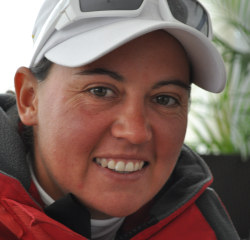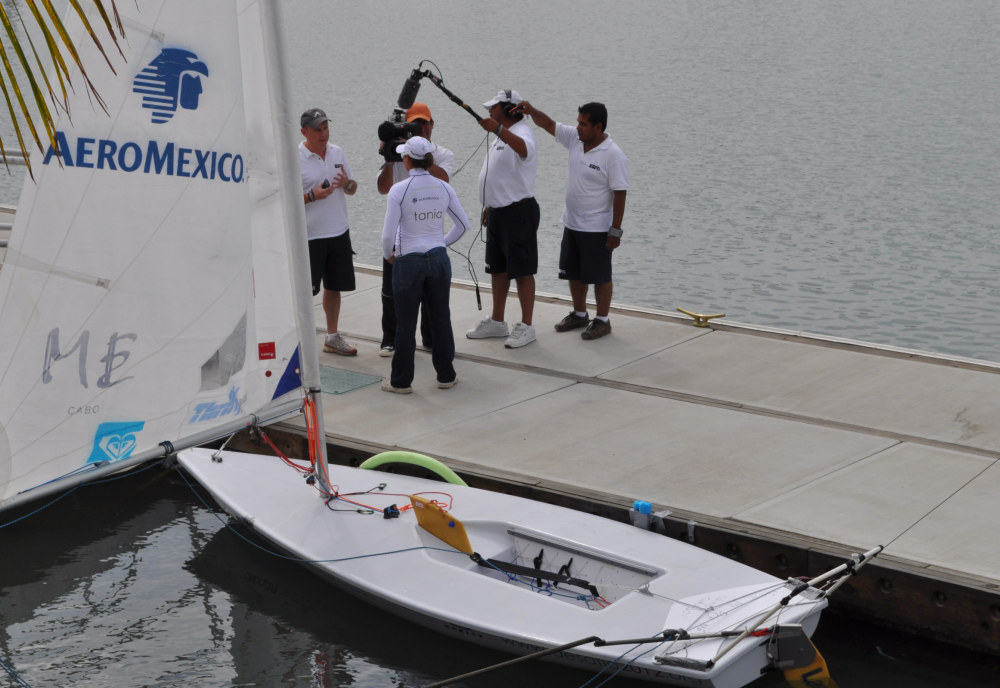Cabo to Mainland on a Laser
Olympic Laser sailor Tania Elias Calles wants you to know that she sails every day in the best place in the world, so come on down and train with her in Mexico at Bahia de Banderas. That is, train on-site for the 2011 Pan Am Games. She’s so serious about this that she just sailed 65 hours from Cabo San Lucas to the mainland—in her Laser—to make the point. And, to set a record. To be numero uno.

Tania at the finish line. Photo by her friend Tania Fichtner
I’ll save you the math. Sixty-five hours is 2 days, 17 hours.
In a Laser, or should we say, on a Laser, because that’s how it is.
The crossing from Cabo to La Cruz de Huanacaxtle is 220 miles on the chart—more like 300 miles as she sailed it—and there were no guarantees this was going to come out right. It was never more true that the sea is so big, and the boat is so small. The next dream is an Olympic medal in 2012. After witnessing the drive and pluck she proved on this journey, we won’t count this woman out.
 “I knew there would be a good wind leaving Cabo,” she says, “and it was quick. I was making 12 knots, and I did that for 14 hours straight. My escort boats could not keep up, and then, twelve hours out, my GPS went out but I knew the compass course I needed to steer. Actually, all my electronics quit working. I was tired, very tired, but I was in that area where the waters of the Sea of Cortez meet the Pacific. It was too rough to stop, and my light was out too, so I couldn’t even read the compass. I had to just pick out a star and focus, focus, focus on that frigging star.
“I knew there would be a good wind leaving Cabo,” she says, “and it was quick. I was making 12 knots, and I did that for 14 hours straight. My escort boats could not keep up, and then, twelve hours out, my GPS went out but I knew the compass course I needed to steer. Actually, all my electronics quit working. I was tired, very tired, but I was in that area where the waters of the Sea of Cortez meet the Pacific. It was too rough to stop, and my light was out too, so I couldn’t even read the compass. I had to just pick out a star and focus, focus, focus on that frigging star.
“Eventually, I had to stop. I just had to. I put the sea anchor out over the bow, but I capsized twice, and that scared me a bit. I had four more hours of night, and I didn’t want to be wet. I guess I rested maybe twenty minutes.”
Fast-forward to morning, and we find Tania dried out, with both of her escort boats back in touch—and another two days to go. Did I mention, this was hard? Tania figures she slept less than two hours in her 65-hour crossing.
 Meeting the press. Photo by Kimball Livingston
Meeting the press. Photo by Kimball Livingston
Tania’s boat had pouches on each side of the cockpit to hold bars and gels (“food I could eat even if it got wet”) and alongside the centerboard were six liters of water per side. A long hose made water accessible from nearly any part of the boat.
Day two was wearing, and near the Marias (islands) Tania hit a light spot where she “spent eleven hours with only three to five knots of wind.” That would be part of what made day three so hard. As in, down to one liter of water with fifty miles to go.
“The last day was the toughest,” she says. “I was dehydrated and I stopped eating because I just couldn’t take the bars anymore. I was falling asleep, and I wouldn’t realize I was asleep until the boat gybed and I would wake up aimed back at Cabo. I was in a waking dream, and I would be wondering why I was still on my boat and wet and tired. But then I saw the Mariettas, and I knew I was going to make it.”
The Mariettas are tiny rocks close to Punta de Mita, marking the entry to Bahia de Banderas and a warm welcome waiting at the dock at La Cruz de Huanacaxtle. I met Tania here last December, and she told me she was going to do this crazy thing. It gives me great pleasure now to report that it came out alright and to agree with her (as I mention from time to time) that Bahia de Banderas really is one of the best places in the world to sail a boat.
Tania arrived on Wednesday. We had our conversation on Thursday, shortly before her standing ovation at the MEXORC daily awards dinner. Her crossing has been an integral component, from the get-go, of the Nextel Regata Copa Mexico.
Meanwhile, MEXORC continues. Maybe eventually I’ll get that story too. Until then, check out Tania Elias Calles at eldesafio2012.org or listen to her tell part of the story by clicking TaniaElias.
